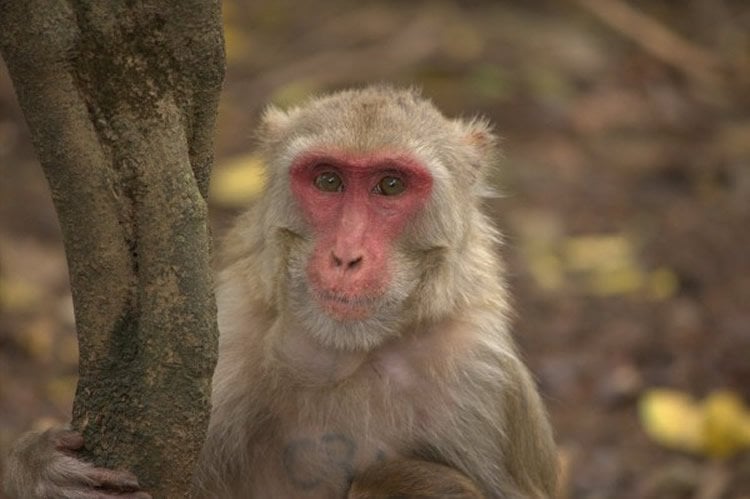Summary: A new study reports the photoreceptors in our eyes allow us to detect socially significant color variations better than other types of color vision.
Source: NYU.
The arrangement of the photoreceptors in our eyes allows us to detect socially significant color variation better than other types of color vision, a team of researchers has found. Specifically, our color vision is superior at spotting “social signaling,” such as blushing or other facial color changes—even when compared to the type of color vision that we design for digital cameras and other photographic devices.
“Our color vision is very strange,” says James Higham, an assistant professor in NYU’s Department of Anthropology and one of the study’s co-authors. “Our green receptor and our red receptor detect very similar colors. One would think that the ideal type of color vision would look different from ours, and when we design color detection, such as for digital cameras, we construct a different type of color vision. However, we’ve now shown that when it comes to spotting changes in color linked to social cues, humans outshine the type of color vision we’ve designed for our technologies.”
The study, which appears in the journal Proceedings of the Royal Society Biological Sciences, focuses on trichromatic color vision—that is, how we process the colors we see, based on comparisons among how red, green, and blue they are.
One particularly interesting thing about how our visual system is structured is how significantly it differs from that of cameras. Notably, the green and red photoreceptors we use for color vision are placed very close together; by contrast, the equivant components in cameras are situated with ample (and even) spacing among them. Given that cameras are designed to optimally capture color, many have concluded that their ability to detect an array of colors should be superior to that of humans and other primates—and wondered why our vision is the way it is.
One idea that has been well-studied is related to foraging. It hypothesizes that primate color vision allows us to detect between subtle shades of green and red, which is useful, for example, when fruit are ripening against green leaves in a tree. An alternative hypothesis relates to the fact that both humans and primates must be able to spot subtle changes in facial color in social interactions. For instance, some species of monkeys give red signals on their faces and on genitals that change color during mating and in social interactions. Similarly, humans exhibit facial color changes such as blushing, which are socially informative signals.
In their study, the researchers had 60 human subjects view a series of digital photographs of female rhesus macaque monkeys. These primates’ facial color has been known to change with their reproductive status, with female faces becoming redder when they are ready to mate. This process, captured in the series of photographs, provides a good model for testing the ability to not only detect colors, but also to spot those linked to social cues—albeit across two species.
In different sets of photographs, the scientists developed software that replicated how colors look under different types of color vision, including different types of color blindness, and the type of trichromatic vision seen in many artificial systems, with even spacing of the green and red photoreceptors. Some of the study’s subjects viewed photos of the transformation of the monkeys’ faces as a human or primate would see them while others saw pictures as a color-blind person would and others as a camera would. During this period, the study’s subjects had to discriminate between the different colors being exhibited by the monkeys in the photos.
Overall, the subjects viewing the images using the human/primate visual system more accurately and more quickly identified changes in the monkeys’ face coloring.

“Humans and many other primates have an unusual type of color vision, and no one is sure why,” first author Chihiro Hiramatsu of Japan’s Kyushu University notes. “Here, we provide one of the first experimental tests of the idea that our unusual vision might be related to detecting social signals in the faces of others.”
“But, perhaps more importantly, these results support a rarely tested idea that social signaling itself, such as the need to detect blushing and facial color changes, might have had a role in the evolution or maintenance of the unusual type of color vision shown in primates, especially those with conspicuous patches of bare skin, including humans, macaques, and many others,” concludes co-author Amanda Melin of the University of Calgary.
Funding: The research was supported by the Japanese Society for the Promotion of Sciences (10J04395) and the Wenner Gren Foundation as well as the National Institutes of Health’s National Center for Research Resources (2P40OD012217) and its Office of Research Infrastructure Programs.
Source: James Devitt – NYU
Image Source: NeuroscienceNews.com image is credited to Constance Dubuc (NYU).
Original Research: Full open access research for “Experimental evidence that primate trichromacy is well suited for detecting primate social colour signals” by Chihiro Hiramatsu, Amanda D. Melin, William L. Allen, Constance Dubuc, and James P. Higham in Proceedings of the Royal Society Biological Sciences. Published online June 14 2017 doi:10.1098/rspb.2016.2458
[cbtabs][cbtab title=”MLA”]NYU “How Detecting Social Signals May Have Affected How We See Colors.” NeuroscienceNews. NeuroscienceNews, 14 June 2017.
<https://neurosciencenews.com/color-perception-social-signals-6912/>.[/cbtab][cbtab title=”APA”]NYU (2017, June 14). How Detecting Social Signals May Have Affected How We See Colors. NeuroscienceNew. Retrieved June 14, 2017 from https://neurosciencenews.com/color-perception-social-signals-6912/[/cbtab][cbtab title=”Chicago”]NYU “How Detecting Social Signals May Have Affected How We See Colors.” https://neurosciencenews.com/color-perception-social-signals-6912/ (accessed June 14, 2017).[/cbtab][/cbtabs]
Abstract
Experimental evidence that primate trichromacy is well suited for detecting primate social colour signals
Primate trichromatic colour vision has been hypothesized to be well tuned for detecting variation in facial coloration, which could be due to selection on either signal wavelengths or the sensitivities of the photoreceptors themselves. We provide one of the first empirical tests of this idea by asking whether, when compared with other visual systems, the information obtained through primate trichromatic vision confers an improved ability to detect the changes in facial colour that female macaque monkeys exhibit when they are proceptive. We presented pairs of digital images of faces of the same monkey to human observers and asked them to select the proceptive face. We tested images that simulated what would be seen by common catarrhine trichromatic vision, two additional trichromatic conditions and three dichromatic conditions. Performance under conditions of common catarrhine trichromacy, and trichromacy with narrowly separated LM cone pigments (common in female platyrrhines), was better than for evenly spaced trichromacy or for any of the dichromatic conditions. These results suggest that primate trichromatic colour vision confers excellent ability to detect meaningful variation in primate face colour. This is consistent with the hypothesis that social information detection has acted on either primate signal spectral reflectance or photoreceptor spectral tuning, or both.
“Experimental evidence that primate trichromacy is well suited for detecting primate social colour signals” by Chihiro Hiramatsu, Amanda D. Melin, William L. Allen, Constance Dubuc, and James P. Higham in Proceedings of the Royal Society Biological Sciences. Published online June 14 2017 doi:10.1098/rspb.2016.2458






